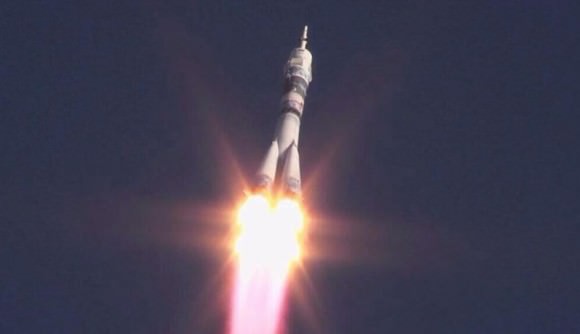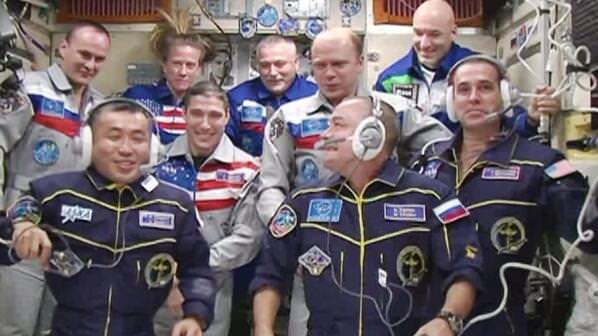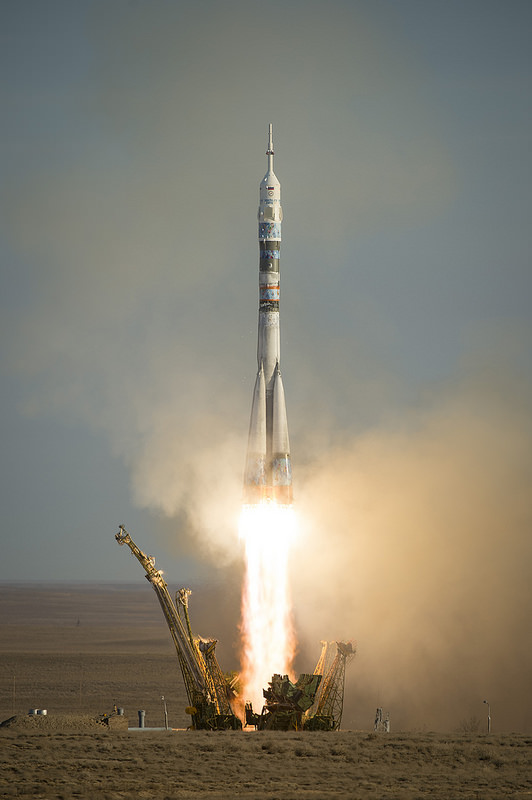Update: the crew has now arrived safely at the ISS. You can watch the arrival video below.
Three new crew members are on their way to the International Space Station. NASA astronaut Rick Mastracchio, Japan Aerospace Exploration Agency astronaut Koichi Wakata and Soyuz Commander Mikhail Tyurin of Roscosmos launched on a Soyuz TMA-11M spacecraft from the Baikonur Cosmodrome at 11:14 p.m. EST (04:14:00 UTC, 10:14 a.m. Thursday, Kazakh time). They’ll use the accelerated “fast-track” trajectory and arrive at the station in just a few hours, at 10:31 UTC (5:31 a.m. EST Thursday.)
You can watch the launch video below.
In an usual situation, when the new crew arrives, there will be nine crew members and three Soyuz vehicles at the ISS. The timing of crew exchange works to enable a complicated “relay race” of a special Olympic torch from the 2014 Sochi Winter Olympics in Russia. The new crew is bringing the unlit torch along, then, over the weekend Russian cosmonauts Oleg Kotov and Sergei Ryazanskiy, who are part of the space station’s current crew, will take the torch out on a spacewalk, with plans to take pictures and video (they’ll try to take pictures when the station flies over Russia and the southern resort of Sochi). The real reason for the spacewalk is to do some routine Russian maintenance outside the station.

Then, on Sunday, three crew members will return home (Fyodor Yurchikhin, Luca Parmitano and Karen Nyberg) and they will bring the torch back home, with landing planned at about 9:50 p.m. EST on Nov 10 (02:50 UTC on Nov 11.) The torch then will be given back to Olympic officials and it will be used in the opening ceremonies of the February games.
After that crew departs, Expedition 38 will begin with Kotov as Commander.

There have not been nine crew members on the ISS since 2009. During the second half of the new crew’s Expedition, when it changes to Expedition 39, Wakata will make history by becoming the first Japanese commander of the International Space Station. You can read more about Wakata and Mastracchio and their upcoming mission in an interview they did with Elizabeth Howell during their training.
The new fast-track trajectory has the Soyuz rocket launching shortly after the ISS passes overhead. Then, additional firings of the vehicle’s thrusters early in its mission expedites the time required for a Russian vehicle to reach the Station, in about 6 hours or four orbits.
Launch video:
Arrival and docking:


God Speed! 🙂
how do they keep the torch burning?
RTFA!
It is unlit and will not be lit in space — too dangerous!
Awesome.
Such a big megalomania just to tell others that Russia has sent to space the olympic torch !! Is there no other mean to use the money instead wasting it for spacing the torch ? This disgusts me.
What disgusts me is that the country that landed on the moon *over forty years ago* now has to hitchhike for a ride into orbit from Russia!
On that note, IMO, I think that any interest in space generated by these non-essential but non-intrusive add-on missions is cool.
How is it “wasting money”? The flight was scheduled, anyway.
How many vessels of human ashes have been taken into space by NASA?
Yes! I am always impressed with Soyuz launches and just love the sound of those rockets! Am SO glad none were ever loaded with hydrogen bombs and sent here, even though we got awful dang close there a couple times.. dzzzzz. It is infinitely better seeing them used to participate in this great international en devour/experiment! Bon voyage Y’all!